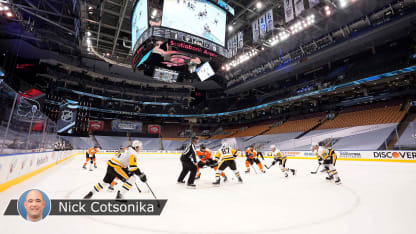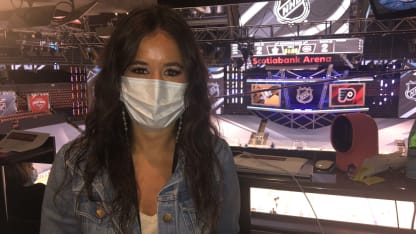The NHL built a new ice sheet at Scotiabank Arena. Other than one skate by officials, this exhibition was first test of the surface. The next test came a couple hours later when the Montreal Canadiens and Toronto Maple Leafs played in the second game of a doubleheader.
"We have a few issues to figure out with the loading dock and keeping doors closed, but we're not loading the building with 18,000 people," said Derek King, NHL senior manager of facilities operations, who oversees the ice crew. "The engineering crew has it dialed in."
Last but not least, you notice the strict medical protocol.
The players arrived at the rink wearing masks. During TV timeouts, the ice crew wore gloves and masks. Between periods, a cleaning crew sterilized the bench areas wearing masks, gloves and medical gowns. Between games, it sterilized everything again -- benches, penalty boxes, locker rooms. Not only did it replace the water bottles, it replaced the water bottle holders.
This continues to be a work in progress, with nothing left to chance. Take the ice crew. The members found their regular shoveling pattern didn't work for social distancing, so after talking to the on-ice officials, they were going to try a new pattern for the second game to stay farther from the players.
"We want to make sure we're doing that right," King said.
Finally, after 138 days without it, we have NHL hockey. It might look different. It might sound different. It might be socially distanced. But it's back.
And soon the Stanley Cup will be at stake.
"It's exciting to develop and kind of test it out during the exhibition games," Riva said, "and then we're pedal to the metal come Saturday."



